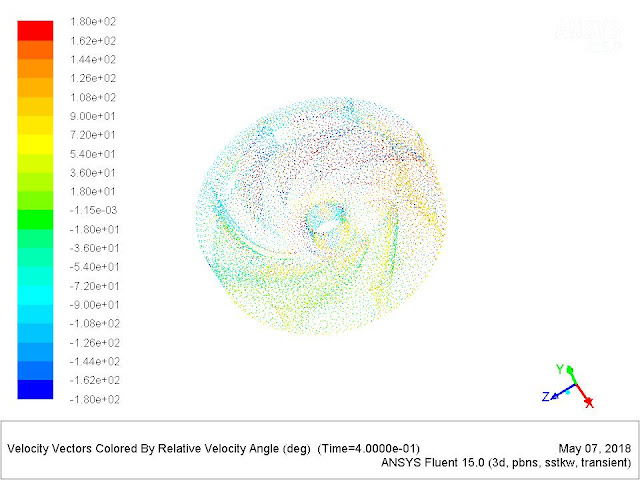Case study on Reverse
blade centrifugal pump
Project type- client confidential
Design:-
Impeller has designed in such a way that the intake
mass flow is very high nearly 40000kg of fluid per hour. Working method is same
as existing centrifugal pumps but when it comes to inlet diameter is very high
when compared with the existing designs. When it comes to normal centrifugal
pumps fluid enters thru a small inlet flows through the blades and exit n
radial direction but in this case fluid enters thru a large diameter inlet with
heavy mass flow and flows through the blades and leaves in radial direction. It
has experimentally tested by the developers and numerical assistance has given
by me thru this study to validate their experimental studies.
Model:-
Deign has given by the respected developers due to
it confidentiality I am not going to display here.
Mesh
Data:-
·
Hexa Elements - Whole Body, Wedge and
Tets to connect.
·
98% structured mesh has been achieved.
·
Advanced-proximity and curvature.
·
Number of Elements – 466653.
·
Number of Nodes – 95010.
Solver
input data:-
Ø Water inlet Temperature : 25°C
Ø Water inlet pipe Suction Pressure : 160 mm of Hg
Ø Viscosity of the fluid : 0.91 Cp at 25° C
Ø Vapour Pressure : 24 Torr
Ø RPM of impeller : 1440
Ø Atm. Pressure and temperature : 101325 N/m2, 25°C at MSL
Ø Flow Medium : Water
Ø Fluid flow rate : 400 meter cube/ hour. or 4, 00,000
kg/hr.
Ø Water density : 1000 kg/ meter cube.
Ø Water Head : 20m
Ø Motor Power : 50 HP
Ø Mass flow rate of
Water : 40000 kg/hr
Ø Material properties of casing & Impeller :
Aluminum alloy
Ø Density (g/centi meter cube) : 2.6898
Ø Modulus of Elasticity (GPa) : 68.3
- Poisson’s Ratio : 0.34
Objectives
observed in the case study:-
1.
Computation to be
carried out at best efficiency point .
2.
Pressure
distribution at impeller inlet and
cavitation inception.
3.
Pressure and
Velocity Distribution around the Impeller blade .
4.
Quality of flow,
non-uniformity factors , at impeller inlet and outlet recirculation, separation
in flow domain .
5. Total
pressure rise, Static pressure rise at impeller outlet.
6. Cavitation
at volute cutwater.
7. Axial,
radial forces.















No comments:
Post a Comment